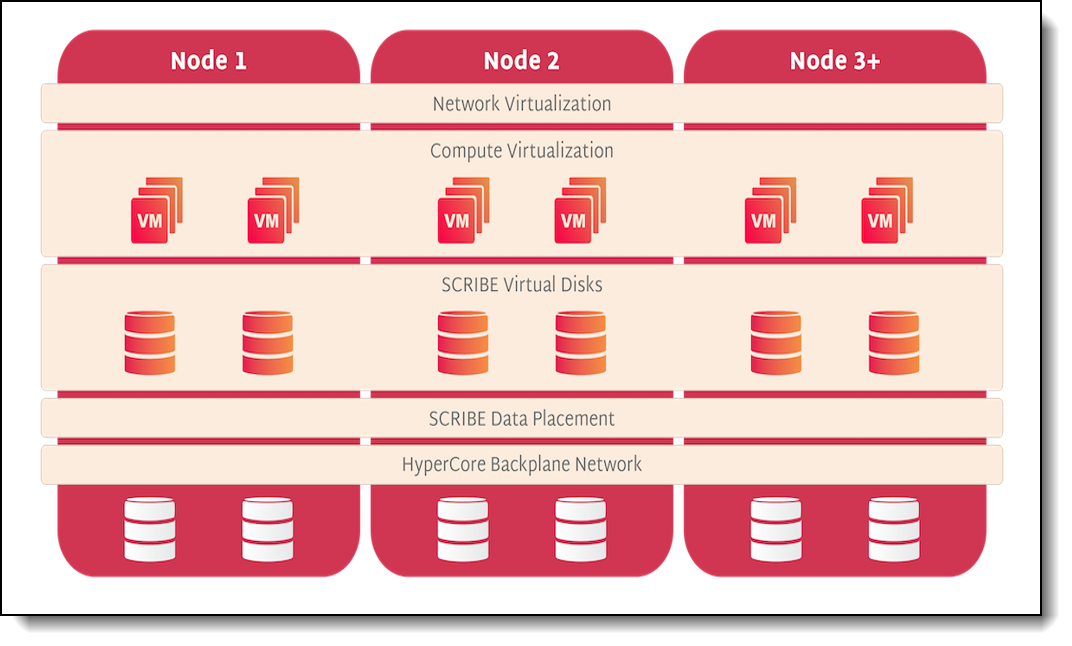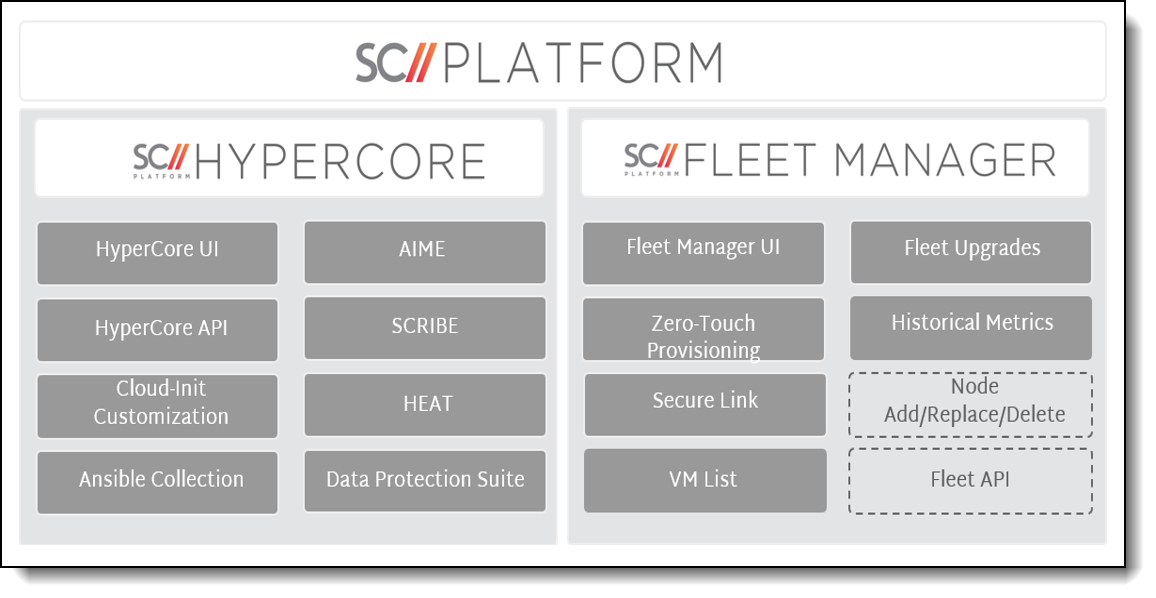Author
Updated
25 Sep 2025Form Number
LP2279PDF size
10 pages, 740 KBAbstract
This solution brief provides essential presales information to understand this hyperconverged infrastructure (HCI) solution from Scale Computing and Lenovo partnership. This guide is intended for technical specialists, sales specialists, sales engineers, IT architects, and other IT professionals who want to learn more about this hyperconverged infrastructure (HCI) solution and consider its use in IT solutions.
Change History
Changes in the September 25, 2025 update:
- Removed SR250 V3 and SE350 V2 as these systems are not in scope
Introduction to Hyperconverged Infrastructure (HCI)
Businesses today face increasing pressure to deliver reliable, high-performance IT services while managing budget constraints and operational complexity. Traditional multi-tier infrastructure is often complex to deploy, manage, and scale. The rise of edge computing introduces new challenges in deploying and managing IT infrastructure across numerous distributed locations. Organizations need a solution that simplifies operations, ensures high availability, scales effortlessly, and extends seamlessly from the central data center to the network edge – all while controlling costs.
The partnership between Scale Computing and Lenovo delivers a transformative solution for IT infrastructure, combining Lenovo's reliable server technology with Scale Computing's HyperCore (SC//HyperCore) software. This collaboration delivers a hyperconverged infrastructure (HCI) platform that is easy to deploy and easy to manage with scalability and high availability. By integrating storage, compute, virtualization, and management into a single system, this solution addresses the needs of both core data centers and edge computing environments. The joint offering is particularly suited for distributed enterprises, retail stores, healthcare facilities, educational institutions, and other industries where application uptime is critical, but IT resources are limited. This brief explores the features, benefits, and use cases of the Scale Computing + Lenovo solution while providing an in-depth analysis of its technical capabilities and business value.
Traditional IT infrastructure often relies on separate components for compute, storage, networking, and virtualization. This siloed approach can lead to inefficiencies in resource utilization, increased complexity in management, and higher operational costs. Hyperconverged infrastructure (HCI) addresses the challenges by integrating storage resources with compute and networking into a unified system, streamlining deployment and management while providing scalability and high availability. Scale Computing Platform (SC//Platform) represents a significant advancement in HCI technology. By combining SC//HyperCore software with the #1 most reliable servers in the industry, Lenovo ThinkSystem servers, the solution offers a turnkey platform that eliminates the need for multiple vendors and complex configurations.
Key Features of Scale Computing HyperCore on Lenovo Servers
SC//HyperCore on Lenovo servers integrates several key features designed to optimize IT operations:
- Integrated Virtualization: SC//HyperCore includes a built-in KVM-based hypervisor, eliminating the need for third-party virtualization software.
- Unified Management: A single web-based interface simplifies management tasks such as provisioning virtual machines (VMs), monitoring performance, and deploying updates.
- Self-Healing Capabilities: The system automatically detects and resolves hardware or software issues to maintain application availability.
- Scalability: Clusters can be expanded seamlessly by adding new nodes without disrupting existing workloads.
- Built-in Data Protection: Features like snapshots, replication, and disaster recovery ensure data integrity and business continuity.
These features make the Scale Computing + Lenovo solution ideal for organizations seeking to modernize their IT infrastructure while reducing complexity and costs.
Technical Architecture
The technical architecture of this solution is designed to deliver a seamless, integrated experience across compute, storage, and virtualization. This section outlines the key hardware and software components that form the foundation of the hyperconverged infrastructure, ensuring performance, reliability, and scalability.
Hardware Components
Lenovo’s ThinkSystem servers form the hardware backbone of this solution. These servers are known for their reliability, performance, and energy efficiency. The following models are commonly used in SC//HyperCore deployments:
- ThinkSystem SR630 V3: A maximum performance, versatile rack server suitable for general-purpose and next-gen workloads.
- ThinkSystem SR650 V3: A high-performance maximum scalability server optimized for demanding applications and future growth.
- ThinkEdge SE100: The most compact, AI-ready edge server on the market, perfect for constrained spaces without compromising performance.
Each server model is pre-configured with SC//HyperCore software to ensure optimal performance out of the box.
Software components
The core of the solution lies in SC//HyperCore software. This operating system integrates storage, compute, and virtualization into a single platform. Key components include:
- HyperCore™ OS: Manages all aspects of the HCI environment, including resource allocation, VM provisioning, and system monitoring.
- Scale Computing Reliable Independent Block Engine (SCRIBE) Storage System: A patented block-access storage architecture that combines all disks in the cluster into a unified pool.
- HyperCore Enhanced Automated Tiering (HEAT) Technology: Automates data placement across hybrid flash storage to optimize performance.
- Data Protection Suite: Provides built-in tools for snapshots, data replication, failover, and recovery.
By leveraging these technologies, SC//Platform delivers a robust foundation for modern IT operations.
Business Value
Beyond technical innovation, this hyperconverged infrastructure (HCI) solution from Scale Computing and Lenovo delivers measurable business value. This section highlights the economic, operational, and strategic benefits that organizations can achieve with it, including cost savings, improved efficiency, and enhanced reliability.
- Economic Benefits
The Scale Computing + Lenovo solution offers significant cost savings and reduces total cost of ownership by up to 40% compared to traditional IT infrastructure:
- Reduced Hardware Costs: By consolidating multiple functions into a single platform, organizations can reduce the number of physical servers required.
- Lower Licensing Fees: The built-in hypervisor eliminates the need for expensive third-party virtualization licenses.
- Decreased Management Overhead: The unified management interface reduces the time and expertise required to administer the system.
For example, organizations transitioning from non-virtualized environments to SC//HyperCore have reported savings of up to 80% in infrastructure management time.
- Operational Efficiency
The simplicity of SC//HyperCore allows IT teams to focus on strategic initiatives rather than routine maintenance tasks. Features like self-healing technology and rolling upgrades minimize downtime while ensuring continuous application availability.
- Scalability and Flexibility
The modular design of SC//HyperCore enables organizations to scale their infrastructure as needed. Whether adding new nodes to support growing workloads or deploying small appliances at remote locations, the solution adapts to changing business requirements.
- Enhanced Reliability
With built-in failover capabilities and advanced data protection features, SC//HyperCore ensures that mission-critical applications remain online even during hardware failures or other disruptions.
Use Cases
The versatility of the Scale Computing + Lenovo solution makes it suitable for a wide range of deployment scenarios. This section explores how the solution addresses the unique needs of edge computing, core data centers, small and medium businesses, and industry-specific applications across retail, healthcare, education, and manufacturing.
Topics in this section:
- Edge Computing - Distributed Enterprise
- Core Data Centers
- Small and Medium Businesses (SMBs)
- Industry-Specific Applications
Edge Computing - Distributed Enterprise
Edge computing environments often face unique challenges such as limited space, lack of onsite IT staff, and the need for real-time data processing. The Scale Computing + Lenovo solution addresses these challenges by providing a compact, easy-to-manage platform that can be deployed at remote locations.
For instance, Delhaize Group implemented SC//Platform for edge on Lenovo servers across its retail stores. This deployment reduced IT management time by 75% while improving recovery times by 99.9%.
Core Data Centers
In traditional data center environments, SC//HyperCore simplifies operations by integrating storage, compute, and virtualization into a single system. Organizations can consolidate workloads onto fewer servers while maintaining high performance and availability.
Small and Medium Businesses (SMBs)
SMBs often lack the resources to manage complex IT infrastructures. The Scale Computing + Lenovo solution provides an affordable yet powerful option for these organizations. For example, NENI Food Production leveraged this solution to enhance its ERP system reliability while keeping costs under control.
Industry-Specific Applications
The flexibility of SC//HyperCore makes it suitable for various industries:
- Retail: Supports point-of-sale systems, inventory management, video surveillance, and IoT applications.
- Healthcare: Enables secure storage of electronic medical records (EMRs) and supports telemedicine applications.
- Education: Facilitates virtual desktop infrastructure (VDI) deployments for remote learning.
- Manufacturing: Integrates with IoT sensors to optimize production processes.
Implementation Process
Deploying the Scale Computing + Lenovo solution involves several key steps:
- Assessment: Evaluate current infrastructure needs and identify workloads suitable for migration.
- Planning: Design an architecture tailored to organizational requirements using Lenovo’s range of server options.
- Deployment: Install pre-configured SC//HyperCore appliances at designated locations.
- Optimization: Fine-tune system settings to maximize performance based on workload characteristics.
- Training: Provide IT staff with training on managing SC//HyperCore using its intuitive interface.
Business partner channel plays a crucial role in this process by offering consulting services, technical support, and training programs.
Future Oulook
As organizations continue to adopt AI, edge computing solutions and hybrid cloud architectures, the demand for scalable HCI platforms is expected to grow. The partnership between Scale Computing and Lenovo positions both companies as leaders in this evolving landscape by delivering innovative solutions that address emerging challenges.
- Advancements in AI-driven automation may further enhance self-healing capabilities within HCI platforms.
- Integration with public cloud services could enable seamless hybrid deployments across on-premises and cloud environments.
- Continued innovation in server hardware will likely improve energy efficiency and computational power.
By staying at the forefront of these trends, Scale Computing and Lenovo are well-equipped to meet future demands.
Conclusion
The combination of SC//HyperCore with Lenovo’s ThinkSystem servers offers a compelling solution for modernizing IT infrastructure. This hyperconverged platform delivers simplicity, scalability, high availability, and cost savings across various use cases—from core data centers to edge computing environments.
Organizations adopting this solution can expect improved operational efficiency, reduced management overheads, enhanced reliability, and greater flexibility in scaling their infrastructure as needed. With proven success stories across industries such as retail, manufacturing, healthcare, and education, the Scale Computing + Lenovo partnership represents a transformative approach to IT infrastructure design.
For organizations seeking to future-proof their operations while optimizing costs and resources today—this joint offering is an investment worth considering.
Author
Alejandro Perez is a WW Enterprise IT Solution Manager within Lenovo’s Infrastructure Solutions Group (ISG). He leads the adoption and integration of Enterprise Infrastructure solutions, serving as the Subject Matter Expert for targeted solution architectures. He collaborates with organic and 3rd party SW ecosystem partners to drive innovation and contribute to the company's success. With over 20 years of experience in the IT industry, he has a strong background in Edge Computing, Business Development, and SAP HANA. He is passionate about bringing new technologies to the market and developing new solutions for regional markets.
Trademarks
Lenovo and the Lenovo logo are trademarks or registered trademarks of Lenovo in the United States, other countries, or both. A current list of Lenovo trademarks is available on the Web at https://www.lenovo.com/us/en/legal/copytrade/.
The following terms are trademarks of Lenovo in the United States, other countries, or both:
Lenovo®
ThinkEdge®
ThinkSystem®
Other company, product, or service names may be trademarks or service marks of others.
Configure and Buy
Full Change History
Changes in the September 25, 2025 update:
- Removed SR250 V3 and SE350 V2 as these systems are not in scope
First published: August 13, 2025
Course Detail
Employees Only Content
The content in this document with a is only visible to employees who are logged in. Logon using your Lenovo ITcode and password via Lenovo single-signon (SSO).
The author of the document has determined that this content is classified as Lenovo Internal and should not be normally be made available to people who are not employees or contractors. This includes partners, customers, and competitors. The reasons may vary and you should reach out to the authors of the document for clarification, if needed. Be cautious about sharing this content with others as it may contain sensitive information.
Any visitor to the Lenovo Press web site who is not logged on will not be able to see this employee-only content. This content is excluded from search engine indexes and will not appear in any search results.
For all users, including logged-in employees, this employee-only content does not appear in the PDF version of this document.
This functionality is cookie based. The web site will normally remember your login state between browser sessions, however, if you clear cookies at the end of a session or work in an Incognito/Private browser window, then you will need to log in each time.
If you have any questions about this feature of the Lenovo Press web, please email David Watts at dwatts@lenovo.com.



